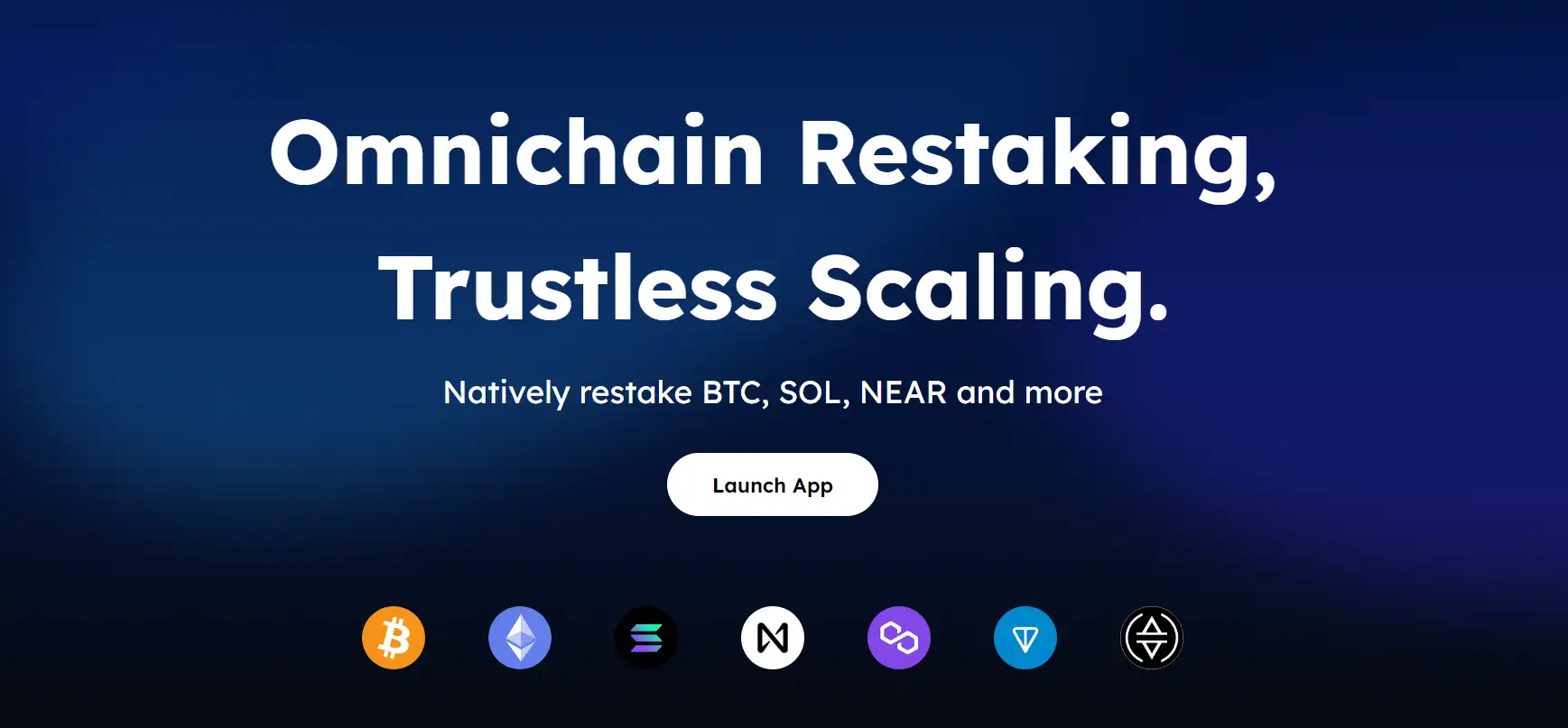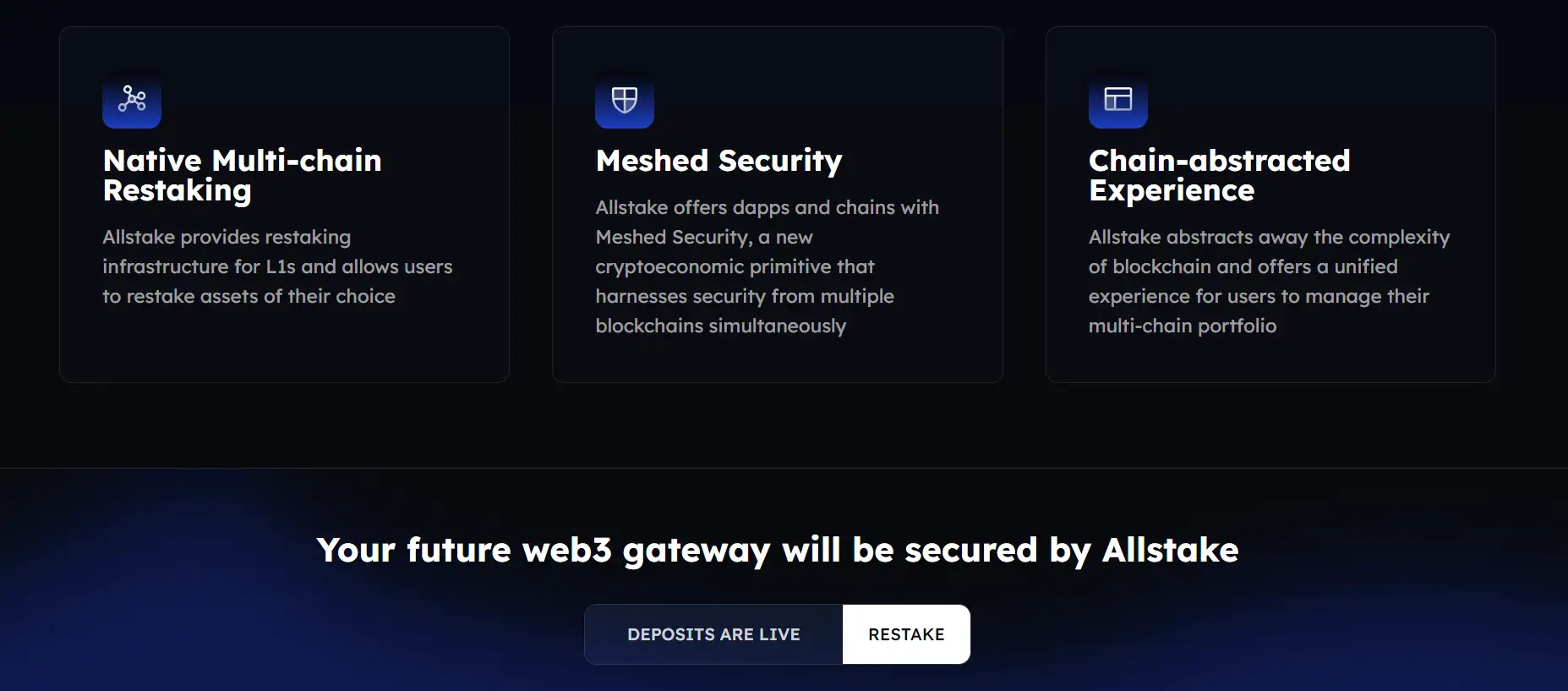About Allstake
Allstake is a revolutionary protocol that introduces the concept of meshed restaking to create a framework for shared security across multiple blockchain networks. The platform is designed to enhance scalability, security, and decentralization, enabling users to natively stake and restake a wide array of assets. By leveraging a modular and decentralized infrastructure, Allstake facilitates staking of Liquid Staking Tokens (LSTs), Liquid Restaking Tokens (LRTs), Liquidity Provider (LP) tokens, and stablecoins across multiple chains such as NEAR, Bitcoin, Ethereum, Solana, and Ton. This innovation eliminates the need for bridges or additional layers, significantly improving interoperability across blockchains.
At its core, Allstake seeks to redefine blockchain security by decoupling consensus and execution. The protocol’s infrastructure, including its restaking hub and chain signature modules, ensures seamless integration and coordination between chains, even for non-smart-contract-compatible blockchains like Bitcoin. Built on the highly scalable NEAR Protocol, Allstake optimizes user experience by enabling intuitive cross-chain staking processes. With its innovative design, Allstake sets itself apart from other staking solutions, addressing critical challenges like validator diversification, censorship resistance, and slashing enforcement across ecosystems. Visit Allstake's official website to explore its potential.
Allstake is a first-of-its-kind meshed restaking protocol built to provide shared security for all blockchains. Unlike traditional staking mechanisms that often operate within a single network, Allstake introduces a multi-chain staking solution that supports a wide variety of assets, including Liquid Staking Tokens (LSTs), Liquid Restaking Tokens (LRTs), Liquidity Provider (LP) tokens, and stablecoins. Its primary innovation lies in its ability to facilitate native staking and restaking across chains like NEAR, Bitcoin, Ethereum, Solana, and Ton. By eliminating the need for bridges or new Layer 1/Layer 2 protocols, Allstake significantly reduces costs and complexity, offering an efficient and secure approach to cross-chain interoperability.
At the heart of the platform is the Allstake Hub, a robust and modular toolkit that ensures seamless restaking operations. This includes a programmable multi-asset economic module, a restaking hub to manage restaking logic, a chain signature module to synchronize states and enforce slashing, and light clients for trustless verification. The hub is strategically built on the NEAR Protocol, chosen for its scalability and efficient chain signature capabilities. Through this infrastructure, Allstake supports validator diversification and actively validated services (AVS), creating a decentralized and censorship-resistant ecosystem. The protocol is also designed to address slashing enforcement, reward issuance, and multi-chain state synchronization, ensuring that user stakes are secure across various blockchain environments.
What sets Allstake apart from competitors such as Lido Finance and StakeWise is its native meshed restaking capability. While other platforms rely on additional layers or bridging mechanisms, Allstake enables direct restaking across blockchains, delivering unparalleled scalability and security. This approach minimizes risks associated with bridges and enhances interoperability without compromising decentralization. For more insights, visit Allstake's official website.
Allstake brings numerous benefits to the blockchain ecosystem. Below are some of its standout features:
- Meshed Restaking: Allows users to stake and restake assets across multiple chains without bridges, ensuring seamless and secure interactions.
- Cross-Chain Interoperability: Native support for chains like Bitcoin, Ethereum, NEAR, and Solana eliminates the need for additional Layer 1/Layer 2 solutions.
- Validator Diversification: Attracts validators from diverse blockchains, enhancing decentralization and censorship resistance.
- Modular Architecture: The toolkit includes programmable economic modules, chain signature modules, and light clients for efficient cross-chain interactions.
- Security Enhancements: Simplifies slashing enforcement and rewards issuance across different chains, ensuring a robust and secure staking process.
For further details, visit Allstake's official website.
Allstake brings numerous benefits to the blockchain ecosystem. Below are some of its standout features:
- Meshed Restaking: Allows users to stake and restake assets across multiple chains without bridges, ensuring seamless and secure interactions.
- Cross-Chain Interoperability: Native support for chains like Bitcoin, Ethereum, NEAR, and Solana eliminates the need for additional Layer 1/Layer 2 solutions.
- Validator Diversification: Attracts validators from diverse blockchains, enhancing decentralization and censorship resistance.
- Modular Architecture: The toolkit includes programmable economic modules, chain signature modules, and light clients for efficient cross-chain interactions.
- Security Enhancements: Simplifies slashing enforcement and rewards issuance across different chains, ensuring a robust and secure staking process.
For further details, visit Allstake's official website.
To get started with Allstake, follow these steps:
- Visit the Official Website: Head to Allstake's official website.
- Create an Account: Register by entering your details and verifying your account.
- Connect Your Wallet: Link your preferred cryptocurrency wallet to start staking and restaking assets.
- Select Assets: Choose from the supported assets, including LSTs, LRTs, LP tokens, and stablecoins.
- Stake or Restake: Follow platform instructions to stake or restake your assets across supported blockchains.
- Manage Your Portfolio: Use the dashboard to monitor staking activities, rewards, and asset status.
To explore detailed guides and tutorials, visit Allstake's official website.
Allstake FAQ
Meshed restaking is a unique feature introduced by Allstake that allows users to stake and restake their assets across multiple blockchains, ensuring seamless integration and shared security. Unlike traditional staking, meshed restaking eliminates the need for bridges or additional layers, offering a trustless and composable approach to enhancing blockchain scalability and security.
Allstake leverages a chain signature module that synchronizes states and enforces slashing across blockchains. This ensures that malicious behavior is penalized while maintaining secure interoperability. By utilizing the NEAR Protocol, Allstake eliminates the vulnerabilities associated with bridges, ensuring a robust and trustless cross-chain ecosystem.
The modular toolkit of Allstake includes a programmable economic module, a restaking hub, a chain signature module, and light clients. These components ensure efficient cross-chain operations, seamless staking, and robust security by enforcing slashing and issuing rewards. This design simplifies complex blockchain interactions, making the platform intuitive and secure for users.
You Might Also Like












